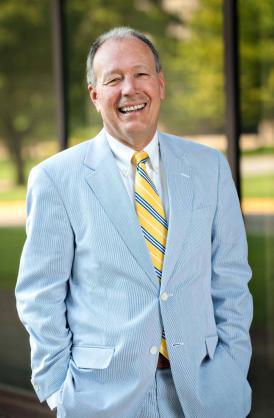Making Meaning through Philanthropy
CSHPE alumnus Jerry May helped to transform every school, college, and program at U-M as vice president for development—a role to which he brought a deep respect for higher education and a passion for connecting with people.
Upon his 2018 retirement as vice president for development, May’s tenure as a fundraiser, a strategic and visionary leader, and a beloved ambassador of the university was celebrated by donors, colleagues, and friends across the world. For four decades, May held leadership positions throughout numerous major campaigns—each one surpassing the goal that was set. He is a trusted, respected advocate for U-M and higher education more broadly. And during his career, he changed the advancement field forever and for the better.

May was dean of students at New England College when he applied to the #1-ranked program in higher education, the SOE’s Center for the Study of Higher and Postsecondary Education (CSHPE). May knew he had a passion for promoting higher education and recognized that CSHPE had the national platform and expertise to prepare him for his next leadership role—perhaps in government relations, student services, budget and finance, or development and alumni relations.
“I was fascinated with organizations,” says May, who fondly recalls working alongside esteemed faculty members Marvin W. Peterson, James L. Miller, Joseph P. Cosand, Bob Blackburn and Zelda F. Gamson. Their expertise, combined with a curriculum that allowed students to explore the many aspects and disciplines at play in the field of higher education, helped May develop his grasp of the depth and complexity of institutions, and also his philosophy as a leader within higher education.
May had already gained exposure to the work of fundraising through his early career. While enrolled in CSHPE, he took charge of U-M's central annual giving operations. Fundraising was a natural fit for May, who found building relationships—which is at the heart of the work—truly rewarding. The role also fulfilled the deep commitment he felt to higher education and allowed him to leverage the formal education he received. May says, “What happened is that my genuine interest in other human beings matched up with my desire to represent and promote higher education.”
For May, philanthropy is an important part of creating meaning in people’s life. “I'm fascinated with getting to know people, how they solve problems, and what they do to have meaning in their lives.”
As his leadership style emerged, he returned to an observation made by professor Gamson. May says, “One particular course was pivotal for me. It was focused on innovation and change within organizations. She described how rare it is to find leaders who are capable of generating a vision and implementing their ideas.” He sought to be one of those rare individuals.
For 13 years, May held leadership positions at U-M before becoming vice president for development at The Ohio State University and president of The Ohio State University Foundation. May returned to U-M in 2003 as vice president for development, where he presided over the Michigan Difference Campaign, which exceeded its $2.5 billion goal to raise $3.2 billion at its conclusion in 2008, and the Victors for Michigan campaign, which surpassed its $4 billion goal to raise $5.28 billion.
May is quick to credit the university’s presidents, deans, and his development colleagues for U-M’s success. One of the great joys of his career was working with academic leaders to communicate their visions and develop strategic plans for executing innovative and transformative ideas.
Another important contribution of May’s career was the way he shaped professional development for fundraisers. May envisioned a model that offered unparalleled opportunities for mentorship and sophisticated training. He recruited Chrissi Rawak to be assistant vice president of talent management and development operations. Together, they launched numerous successful efforts to attract, train, and retain outstanding fundraisers, including the nationally recognized Development Summer Internship Program (DSIP).
May’s appreciation for great teaching molded how he imagined his role: “I have always loved teaching and, at one point, I had thought about teaching in higher education. I’m more passionate about fundraising but I love teaching, so I taught my whole career and I particularly taught my last 25 years.” He taught in U-M Development training programs, lectured in various U-M schools, taught in national CASE programs and for 25 years, he taught in the Big Ten Fund Raisers Institute (BTFRI).
The Council for Advancement and Support of Education honored May with the 2019 Frank L. Ashmore Award for Service to CASE and Advancement. This recognition underscored his service to the profession and his efforts to grow the profession in innovative and sustaining ways.
May cherishes his many friendships with alumni and donors of the university. Like many of the donors with whom he worked, May enjoys meeting the students who receive the scholarship that bears his name. The Scholarship was endowed by U-M donors and friends. It has been such as source of gratification that he and his wife, Deb, are establishing another scholarship. Among the many things that have brought great meaning to their lives is watching scholarship recipients transform through their college experiences.
May says of scholarships, “One of the things that I did—if I did anything—was that I worked on hundreds, if not thousands, of scholarship funds. When you ask me about the satisfaction I felt in my career, the emotion I feel right now, two years later, talking about scholarships, that’s it!”